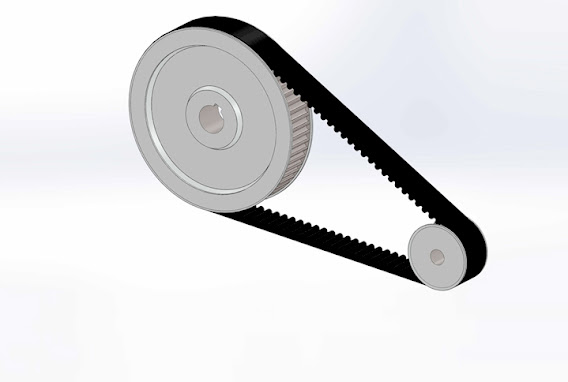Timing belt
Timing belt is used in the internal combustion engine or machines and
rotates shafts synchronously to operate the engine or machine
properly. It is generally used for transmission of rotary motion between
shafts.
Timing belt is the arrangement of teeth inside surface or outside surface or both sides of the belt which helps to operate precise rotation of shaft. There is no slip between the pulley and timing belt resulting it maintains constant speed and specific timed position. Timing belt types depend on the application of uses.
It is made with Synthetic rubber and most commonly used in the engine and synchronous rotation between camshaft and crankshaft and it is also using to advance CNC machine and robotic machines.
Timing belt types
Types of timing belt is the common insights for selecting before using to the machine or engine. Different types of timing belts are used under different circumstances and environment.There are two main types of timing belt used in automotive and industrial machinery.
- Single side teeth timing belt
- Double side teeth timing belt
According to the tooth shape timing belt are classified as Trapezoidal and curvilinear type
Curvilinear timing belt
The curvilinear timing belt tooth shaped is like a half circle or arc. Due to higher contact area curvilinear belts have a good power transmitting capacity. Curvilinear timing belt most commonly used in automotive engine for transmitting rotational power.
Trapezoidal timing belt
This timing belt consist of Taperized teeth. Taperized belt are most commonly used in industrial machinery for linear positioning and conveying applications. Less transmission power than curvilinear timing belt.
Timing belt construction material
Timing belt Consist of SS wire or Cord, Nylon/rubber coating and Neoprene (Base material)SS wire or cord: SS wire or cord carry the load of timing belt during transmitting rotation between shafts. There are different materials like metal wire, polyester cord and fibers are used to make ss wire or cords.
Neoprene (Base material):Neoprene or base material protects the wire and keep way the belts from oily and moisturizing.
Nylon or rubber coating: Nylon or rubber coating reduce the friction of the belt and make it strong and provide maximum performance.
Timing belt replacement cost
Timing belt replacement cost will depend on how many labor your need to replace it.Replacing timing belts is more expensive for large vehicles than small vehicles. Auto Mechanics quotes will be different in each shop.
Common reasons for timing belt replacement
- Vehicle manufacturer manual will provide the approximate time to change the belt.It might be 60000 kilometer to 90000 kilometer.
- Engine will not start due to timing belt can break while engine running.
- If the teeth damages after engine running thousands of miles.
Advantages and disadvantages of timing belt
Advantages
- No lubrication is required.
- Reduced noise
- Less weights
- Mechanical efficiency is very high
- No power transmission losses.
- Low vibration
Disadvantages
- It is affected by oil and grease.
- Higher bearing loads
- Overheat damage the belt.
Our facebook group





Post a Comment